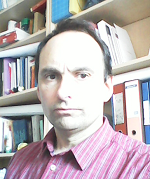PROFILO PERSONALE
- Home/
- Staff: Giovanni La Penna

Giovanni La Penna
Primo Ricercatore
Contatti
Email: giovanni.lapenna@iccom.cnr.it
Telefono: +39 055 522 5264
Sede: Firenze
Indirizzo: Area della Ricerca CNR di Firenze, Via Madonna del Piano 10, 50019 Sesto Fiorentino (FI)
Biosketch:
Education: PhD in Chemical Sciences, University of Pisa (I), 29/10/1996; Master degree in chemistry, University of Firenze (I), 14/11/1991.
Work Experience: Study contract with IBM, 1/11/1991-30/06/1992; Research fellowship, Chemistry dept., Univ. of Southampton (UK), 3/1 – 19/4/1996; Grant with National Institute for Condensed Matter (INFM), Scuola Normale Superiore, Pisa (I), 1/5/1996-30/4/1997; Researcher of the National Research Council, Institute for Macromolecular Studies (ISMac), Genova (I), 1/8/1997-31/01/2007.
Management: COST project CM1305 Explicit control over spin states in technology and biochemistry, http://www.ecostbio.eu, 2014-2018; Bilateral project Cnr/PAN (Warsaw), The role of copper ions in neurodegeneration: molecular models, 2017-2019; Bilateral project Cnr/CNRS (Toulouse), Identification of effective mechanisms for the oxido-reductive reactions catalyzed by copper bound to amyloid-beta peptides2012-2013.
Teaching: Lecturer at INDICASAT, Panama, 6/2018 and 7/2019, http://indicasat.org.pa ; Lecturer at the XIX School of Pure and Applied Biophysics on Theoretical and Computational Approaches to Biophysics, Istituto Veneto di Scienze, Lettere ed Arti, Venezia (2015).
Visiting: University College Cork (IE), 19/1-16/2/2019; Institut de Quimica Computational, Girona (E), 6/2009; Laboratoire de chimie de coordination, CNRS Toulouse (F), 5/2009.
Bibliometric data: WoS 4/3/2019, total articles 72, articles with citation data 66, sum of the times cited 773, average citation per article 11.7, h-index 18.
Research Interests: I apply numerical models to describe biological and chemical processes involving transition metal ions at atomic level. Models range from continuum theories (diffusive dynamics and Monte Carlo in mean fields), molecular dynamics with classical empirical force-fields, to semi-empirical (tight-binding) and density-functional theory approximations for valence electrons. Systems range from hundreds to milions of atoms. Different lenght and time scales are more or less empirically combined. Special methods in statistical mechanics are applied to overtake sampling issues.
